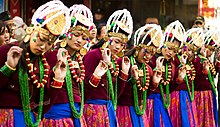Loading AI tools
Ethnic group of South Asia From Wikipedia, the free encyclopedia
Gurung (exonym; Nepali: गुरुङ) or Tamu (endonym; Gurung: རྟམུ) are a Tibetan ethnic group living in the hills and mountains of Gandaki Province of Nepal.[4] Gurungs speak Tamu kyi which is a Sino-Tibetan language derived from the Tibeto-Burman language family. The written form of Gurung is heavily dependent on the Tibetan script and history and details related to their culture and tradition is passed on from one generation to the other usually by word-of-mouth.
This article needs additional citations for verification. (September 2024) |
 Gurung Ghatu Dance in Tamu Losar festival | |
| Regions with significant populations | |
|---|---|
| Manang, Parbat, Lamjung, Mustang, Gorkha, Kaski, Tanahun, Syangja and Dolpa | |
| 543,790 (2021)[1] | |
| 139,000 (above)
USA 17,000 (2023) UK 75,000 (2023)[2] | |
| Languages | |
| Nepali (Lingua Franca), Gurung (Tamu kyi, Manangi, Mustangi, Loki), Seke | |
| Religion | |
| Buddhism (67.4%), Hinduism (28.16%), Bon (2.32%), Christianity (2.12%)[3] | |
| Related ethnic groups | |
| Tibetan, Qiang, Tamang, Magar, Thakali, Sherpa | |
| Gurung people | |||||
|---|---|---|---|---|---|
| Tibetan name | |||||
| Tibetan | ཏམུ | ||||
| |||||
This section contains relative time references such as now, soon, upcoming. (September 2024) |
The origin of the Gurung people can be traced back to Qiang people located in Qinghai, China. As a result of foreign and Korean Christian missionary activities, some Gurung people have also converted to Christianity.[5]
After the end of the Anglo-Nepalese War and the signing of the Treaty of Sugauli in 1816, the British started recruiting soldiers into the British Army from the northern villages of Nepal. The majority of these soldiers come from four ethnic tribes one of which is the Gurung tribe.
To this day, Gurungs continue to be recruited in the British, Indian and Bruneian armies and the Singapore Police Force (under British supervision) as regular soldiers and police officers who retire after serving for anywhere from 15 to 35 years. Upon retiring, with the exception of India, the soldiers and police officers serving in the British and Bruneian armies and Singapore Police Force had to return to Nepal.
However, in 1999, the British government updated its policy under the original 1816 Treaty of Sugauli and allowed Gurkha British Army retirees to settle with their families in the United Kingdom. As a result, since the early 2000s, there have been a large migration of Gurungs from Nepal to England, Wales and Scotland. The number of British Gurkha citizens today totalled in the tens of thousands and is expected to increase.
Despite the Singaporean government relying on the British for recruitment of their Gurkha police officers, it has not updated its policy on the Treaty of Sugauli and continue to forcefully return the police retirees to Nepal despite the majority of their children being born and educated in Singapore.
In the last two decades, the majority of the children of these British, Indian, Bruneian and Singapore servicemen have become better educated. They have gone on to first study and then, work and settle in other Western nations.
The United States of America has seen a huge influx of Nepalese American Gurungs numbering in the thousands in the last two decades. Today Gurungs work in both blue and white collar jobs in the Western world. This number is expected to increase as an increasing number of young Gurungs leave Nepal in search of a better life due to the absence of good governance, massive corruption and lack of opportunities to improve their lives in Nepal since 1990.
The first Nepalese American to be appointed a judge is a granddaughter of a retired Gurkha Contingent Singapore Police Force inspector from Bhukha Deurali village, Parbat.


At the time of the 2011 Nepal census, 798,658 people (2.97% of the population of Nepal) identified as Gurung. The proportions of Gurung people by province was as follows:
The proportions of Gurung people were higher than national average in the following districts:
| Caste (jāt) | Traditional occupation | Clan titles (kul) or surnames (thar) | Notes |
|---|---|---|---|
| 1.
Four Clans (45%) |
Buddhist family and Buddhist monk | Tamu: Kle, Lam, Kon, and Lem Nepali: Ghale, Lama, Ghotaney and Lamichane |
Buddhist priests and family priests of mostly from Parbat ,Lamjung and Tanahu. During the 13th Dalai Lama's visit to Nepal in the early 20th century, the then Rana rulers appointed the esteemed monk from the village of Bhuka Deurali in Parbat district, Kumbasing Gurung as the Buddhist community's representative for northwestern Nepal. Lama Gurung had previously studied together with the 13th Dalai Lama in Tibet. |
| 2.
Sixteen Clans (65%) |
Farmers and shepherd | Tamu: Pachyu, Ghyapri Nepali: Paju, Ghyabring |
Buddhist family from Syangja and Kaski |
Gurung Dharma include Bon Lam (Lama), Ghyabri (Ghyabring) and Pachyu (Paju).[7] Lamas perform Buddhist rituals as needed, such as in birth, funeral, other family rituals (such as in Domang, Tharchang) and in Lhosar. Lamas perform Buddhist ceremonies primarily in Lamjung, Parbat, Kaski, Manang, Mustang, and elsewhere. Some Gurung villages have kept remnants of a pre-Buddhist form of the ‘Bon' religion, which flourished over two thousand years ago across much of Tibet and Western China. They have also kept aspects of an even older shamanic belief system that served as a counter to the Bon religion.[8]
Seamless Wikipedia browsing. On steroids.
Every time you click a link to Wikipedia, Wiktionary or Wikiquote in your browser's search results, it will show the modern Wikiwand interface.
Wikiwand extension is a five stars, simple, with minimum permission required to keep your browsing private, safe and transparent.